The Bric-à-Brac BTB/POZ transcription factors are necessary in niche cells for germline stem cells establishment and homeostasis through control of BMP/DPP signaling in the Drosophila melanogaster ovary
- PMID: 33151937
- PMCID: PMC7643948
- DOI: 10.1371/journal.pgen.1009128
The Bric-à-Brac BTB/POZ transcription factors are necessary in niche cells for germline stem cells establishment and homeostasis through control of BMP/DPP signaling in the Drosophila melanogaster ovary
Abstract
Many studies have focused on the mechanisms of stem cell maintenance via their interaction with a particular niche or microenvironment in adult tissues, but how formation of a functional niche is initiated, including how stem cells within a niche are established, is less well understood. Adult Drosophila melanogaster ovary Germline Stem Cell (GSC) niches are comprised of somatic cells forming a stack called a Terminal Filament (TF) and associated Cap and Escort Cells (CCs and ECs, respectively), which are in direct contact with GSCs. In the adult ovary, the transcription factor Engrailed is specifically expressed in niche cells where it directly controls expression of the decapentaplegic (dpp) gene encoding a member of the Bone Morphogenetic Protein (BMP) family of secreted signaling molecules, which are key factors for GSC maintenance. In larval ovaries, in response to BMP signaling from newly formed niches, adjacent primordial germ cells become GSCs. The bric-à-brac paralogs (bab1 and bab2) encode BTB/POZ domain-containing transcription factors that are expressed in developing niches of larval ovaries. We show here that their functions are necessary specifically within precursor cells for TF formation during these stages. We also identify a new function for Bab1 and Bab2 within developing niches for GSC establishment in the larval ovary and for robust GSC maintenance in the adult. Moreover, we show that the presence of Bab proteins in niche cells is necessary for activation of transgenes reporting dpp expression as of larval stages in otherwise correctly specified Cap Cells, independently of Engrailed and its paralog Invected (En/Inv). Moreover, strong reduction of engrailed/invected expression during larval stages does not impair TF formation and only partially reduces GSC numbers. In the adult ovary, Bab proteins are also required for dpp reporter expression in CCs. Finally, when bab2 was overexpressed at this stage in somatic cells outside of the niche, there were no detectable levels of ectopic En/Inv, but ectopic expression of a dpp transgene was found in these cells and BMP signaling activation was induced in adjacent germ cells, which produced GSC-like tumors. Together, these results indicate that Bab transcription factors are positive regulators of BMP signaling in niche cells for establishment and homeostasis of GSCs in the Drosophila ovary.
Conflict of interest statement
The authors have declared that no competing interests exist.
Figures
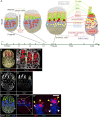
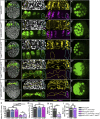
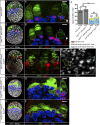


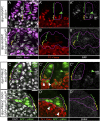
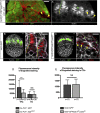

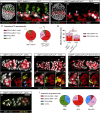
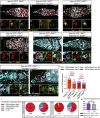
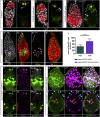
Similar articles
-
Genetic basis for developmental homeostasis of germline stem cell niche number: a network of Tramtrack-Group nuclear BTB factors.PLoS One. 2012;7(11):e49958. doi: 10.1371/journal.pone.0049958. Epub 2012 Nov 21. PLoS One. 2012. PMID: 23185495 Free PMC article.
-
Cytoneme-mediated delivery of hedgehog regulates the expression of bone morphogenetic proteins to maintain germline stem cells in Drosophila.PLoS Biol. 2012;10(4):e1001298. doi: 10.1371/journal.pbio.1001298. Epub 2012 Apr 3. PLoS Biol. 2012. PMID: 22509132 Free PMC article.
-
Traffic jam regulates the function of the ovarian germline stem cell progeny differentiation niche during pre-adult stage in Drosophila.Sci Rep. 2019 Jul 12;9(1):10124. doi: 10.1038/s41598-019-45317-6. Sci Rep. 2019. PMID: 31300663 Free PMC article.
-
Restricting self-renewal signals within the stem cell niche: multiple levels of control.Curr Opin Genet Dev. 2011 Dec;21(6):684-9. doi: 10.1016/j.gde.2011.07.008. Epub 2011 Aug 19. Curr Opin Genet Dev. 2011. PMID: 21862315 Review.
-
Molecular control of the female germline stem cell niche size in Drosophila.Cell Mol Life Sci. 2019 Nov;76(21):4309-4317. doi: 10.1007/s00018-019-03223-0. Epub 2019 Jul 12. Cell Mol Life Sci. 2019. PMID: 31300869 Free PMC article. Review.
Cited by
-
Distinct gene expression dynamics in germ line and somatic tissue during ovariole morphogenesis in Drosophila melanogaster.G3 (Bethesda). 2022 Feb 4;12(2):jkab305. doi: 10.1093/g3journal/jkab305. G3 (Bethesda). 2022. PMID: 34849771 Free PMC article.
-
A sexually transmitted sugar orchestrates reproductive responses to nutritional stress.Nat Commun. 2024 Oct 1;15(1):8477. doi: 10.1038/s41467-024-52807-3. Nat Commun. 2024. PMID: 39353950 Free PMC article.
-
Niche formation and function in developing tissue: studies from the Drosophila ovary.Cell Commun Signal. 2023 Jan 27;21(1):23. doi: 10.1186/s12964-022-01035-7. Cell Commun Signal. 2023. PMID: 36707894 Free PMC article. Review.
-
A dual role of lola in Drosophila ovary development: regulating stem cell niche establishment and repressing apoptosis.Cell Death Dis. 2022 Sep 2;13(9):756. doi: 10.1038/s41419-022-05195-9. Cell Death Dis. 2022. PMID: 36056003 Free PMC article.
References
Publication types
MeSH terms
Substances
Grants and funding
LinkOut - more resources
Full Text Sources
Molecular Biology Databases
Research Materials
Miscellaneous

